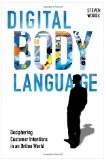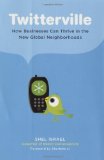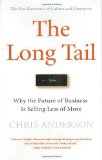PRMM Interview Part 1: Dannette Veale of Cisco on Innovative Virtual Events
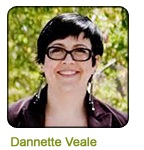 Following previous interviews with key virtual event vendors, I interviewed Dannette Veale, Virtual & Social Technology Strategist, Global Sales Experience (GSX) of Cisco, to get an end-user perspective about virtual events and what technology innovations we can anticipate. Now a member of the Cisco Global Sales Experience team, Dannette previously produced the global Cisco Live and Networkers conferences as hybrid events. She will be speaking at the Virtual Edge Summit on future trends for virtual and hybrid events on January 12, 2023 from 2:15 – 3:00 pm.
Following previous interviews with key virtual event vendors, I interviewed Dannette Veale, Virtual & Social Technology Strategist, Global Sales Experience (GSX) of Cisco, to get an end-user perspective about virtual events and what technology innovations we can anticipate. Now a member of the Cisco Global Sales Experience team, Dannette previously produced the global Cisco Live and Networkers conferences as hybrid events. She will be speaking at the Virtual Edge Summit on future trends for virtual and hybrid events on January 12, 2023 from 2:15 – 3:00 pm.
In Part 1, we discussed virtual events, the pros and cons of being an innovator, and how Cisco leveraged several technologies for the Cisco Live hybrid events. In part 2, to be published next week, Dannette shared her predictions for events in 2011. Hint: it’s about mobility. Please leave any questions you have for Dannette in the comments.
How are virtual events being leveraged within Cisco?
Cisco leverages virtual in many ways. We have flagship events like Cisco Live, which is annual user event with several points around the world, and Partner Summit event, which is our single point of activity for partner communities. And there are internal events, like the Strategic Leadership Offsite (SLO) and GSX (Global Sales Experience). We see virtual as a way to most cost-effectively take event activities to a mass audience.
For majority, Partner Summit and Cisco Live events around the globe, are physical events that are hybrid to extend the activity to a worldwide audience. There is some unique programming for virtual audiences. We don’t clone or repeat everything at physical event. We look at what will translate to the virtual and opportunities to create an experience that can’t be done at the physical event.
For example, keynotes are always presented at Cisco Live and taken to virtual audience. Virtual provides a unique or intimate experience for a post keynote chat session. Keynote speaker goes into a room to have a dialogue with the audience for questions that came up during the keynote. We leverage a space that the speaker can do an intimate chat with 10K people on site in Las Vegas and 30k+ people attending virtually.
That is where we see how virtual offers opportunities that you can’t facilitate at the physical.And some in the physical won’t translate well into virtual. We have a technical solutions clinic on site at Cisco Live for attendees to visit on an ad hoc basis to work with Cisco support regarding deployment issues. In the technical solutions clinic the primary source for sharing information is a white board, this format is difficult to translate virtually. Therefore we have a modified version for virtual that we call the Ask the Expert Center, providing this on a schedule basis versus intervals. When you have 10-15K onsite, there will be plenty of foot traffic to the technical solutions clinic. In the virtual environment, the open-ended aspect doesn’t work as well and virtual attendees respond better with scheduled activities, such as ask-the-expert activities.
You’re incorporating several innovative technologies, such as augmented reality and QR codes. What are your recommendations for others considering using technology for their events? Pros and cons?
We haven’t rolled out some of the technology you mentioned. We had augmented reality (AR) featured at Cisco Live Europe 2010 with keynote speaker, Prof. Bruce Thomas, and used some AR tools on stage to demo power. But we haven’t done what I feel we can do to integrate this on the tradeshow floor.
We also haven’t done a lot with QR codes, and I have blogged a lot about how to leverage it for an event. Rather, we’ve leveraged more social tools like geo-location with Foursquare and DoubleDutch (white-labeled) for Cisco events. We’ve also used Ustream with Facebook and Twitter.
While we haven’t done much for events yet, we can push the envelope with AR and I would love to see a on site and virtual blended scavenger hunt leveraging QR codes, but not at this time.
What are the pros or cons of doing this?
Pro is that we were first – a trailblazer for virtual event opportunities in general. Use that as the specific pro and con for technology.
As an early adopter, we can have a much more dynamic effect on the evolution of that industry and technology offer. There is something to be said about partnering with the companies on these technologies to evangelize the business prospect regarding what we need from these technologies. The earlier we participate on this, the more influence we can have on their long-term road maps.
Con is that sometimes things don’t work. Once we’ve done it and publicized, we have to be ok with saying that it didn’t work. For example I have some blogs about gaming implementation for CiscoLive 2010. Some goals that were on the scope couldn’t’ be realized within the timeframe of deployment. We had to be ok with saying that we didn’t meet all the objectives and met 50% of them, while pursuing the other later. That can be perceived as a con – I don’t personally see this as a con and think it’s about being a good thought leader in the space.
Dannette Veale’s Bio
As the virtual and social technology strategist for Cisco’s Global Sales Experience (GSX), Dannette Veale lives and breathes new media. Prior to her role on the GSX team Dannette lead the creation and drove the strategy for the award winning Cisco Live and Networkers virtual program. Dannette has also managed global online and virtual programs for a variety of Cisco groups; most notably emerging markets. When she’s not evangelizing the use of virtual environments to extend the reach of an event and broaden the overall audience demographic participating, you’ll find Dannette engaged in such varied hobbies as producing streaming media, designing Web sites, or watching classic films such as Blade Runner. Outside of her daily immersion in the bleeding edge of collaborative media, Dannette’s also been known to partake in such real world activities as gardening, baking, and knitting;while watching cyberpunk anime, of course.
Story of Santa John, the Unmerry Macy’s and Lefty O’Doul’s Saves Santa
This past weekend, a story unfolded in the San Francisco area about a Santa Claus, known as Santa John, who was fired from his 20-year job at Macy’s. The issue was about a joke that Santa John told two adult customers sitting on his lap (that’s another issue altogether =). He had said the joke often but this one time got him fired as the customers objected to his “knowing where all the naughty boys and girls lived.”
Now begins a story that pushes Santa John into the limelight, positions Macy’s unfavorably to a world audience, and takes a beloved watering hole, Lefty O’Douls, front and center.
Macy’s Continued Silence
In any other case, the firing of a Santa who told a raunchy joke would have blown over for Macy’s. However, this was a situation in which Santa John has been the face of Christmas for the Macy’s San Francisco flagship store for the past 20 years. As such, Santa John holds an emotional tie to many in the community which has further propelled this story beyond the Bay Area community.
And throughout all this, Macy’s continues to stay silent on this, considering this a “personnel matter”. And this is Macy’s biggest mistake. The company has failed to recognize this as a unique situation. This was an opportunity for the company to highlight their high quality of service to all customers and that they take customer satisfaction seriously. This was an opportunity to apologize for their mistake, acknowledge the 1,000 of emails and letters to rehire Santa John back, and hold a large cermony on Santa John’s return to demonstrate Macy’s Christmas spirit.
Rather, by remaining silent, Macy’s is seen as a harsh employer who fired a beloved holiday icon over one complaint despite 20 years of loyal service.
Lefty O’Doul’s Saves Santa
If you’ve been to San Francisco, it’s very likely you’ve frequented Lefty O’Doul’s, a bar off Union Square. As the story unfolded regarding Santa John, the management at Lefty’s did a brilliant move of offering Santa John a job at the bar – double the pay and a bigger seat.
While there have been job offers for Santa John, this one captured the local media’s attention: local angle, well-known bar establishment located blocks from the very same Macy’s store, and better benefits for Santa John. And best of all, permission to tell all the jokes he wants.
This move is what David Meerman Scott highlights in his book “Real-Time Marketing & PR: How to Instantly Engage with Your Market, Connect with Customers, and Create Products that Grow Your Business.”
Conclusion: The Holiday Spirit
The story of Santa John provides a blueprint on how brands, both small and large, should and shouldn’t handle communications issues. In the new era of transparency, Macy’s could (should?) have been more open and willing to admit a possible mistake. In the end, Lefty’s demonstrated a holiday spirit that benefitted Santa John and inevitably drive more traffic and business to Lefty’s.
And in a time when money is still tight and customers more selective, I suspect that the San Francisco Macy’s year-over-year sales and traffic may dip as a result.
What do you think?
2011 Virtual Event Predictions

by kevin033 via flickr
A few weeks ago, Dennis Shiao of It’s All Virtual queried me on my top predictions for virtual events in 2011. And then this same question appeared on Focus, a network for business professionals to respond and answer to critical business questions. Based on my responses to these, here is a summary of my top three predictions for the virtual events industry.
Market Consolidation Ahead
While there are several known players in the market – 6Connex, Inxpo, On24 and Unisfair – there has been a proliferation of new players and those who have gained mindshare in the industry, such as Expos2, Imaste, Stream57, VisualMente, Ubivent, and others. While this is great for the customer – more choice and usually a decrease in price – I believe this will lead to some players being bought by larger organizations, merging to bring together complimentary strengths, or even some disappearing from the industry all together. No matter how, we will begin to see some consolidation within the industry.
Build Me a Better Playground
I believe the industry players remaining on the landscape will begin building out an ecosystem of services to plug-and-play on the platforms. While each provider has an “open API” the question is at what point will the providers a) begin developing apps to harvest the potential of the data and platforms. This includes connecting to Salesforce or truly automating the marketing aspect of virtual. And b) promote a developer community to build third-party apps for its customers. I envision the latter being more of an end of 2011/early 2012 development.
Simplified Web Experiences
This may seem contradictory to point 2, but I think we’re going to see a move away from the current way we experience virtual events – a login to enter a space with different rooms, like an auditorium, lounge, etc. Rather, I think we will see a return to a “website-like” experience. Everything is on a single page with a window for live streaming video and different widgets for engagement, games and other applications can be added or deleted as needed. And with an OpenID model, I can move freely to and from these “virtual events” without re-entering my login/password. Look for someone like Facebook to move more into this space in 2011.
Do you agree or disagree? What are you top predictions?
The End of Objective News
Over the past few months, my husband and I have discussed the direction that news is heading; and oftentimes, I’m left with the conclusion that news is heading down the wrong path. With this past political cycle and recent posts by Media Bullseye and B.L. Ochman, I’ve come to this conclusion:
The era of striving for objective news has ended
Don’t get me wrong, while the news organizations seek to report just the facts, news has always contained a sliver of perspective that shaped the tone and angle of the story as B.L. indicated in her post. However, the line between conjecture/opinion and reporting the news has been blurred to a point that the general public can no longer delineate one from another.
The competitive, 24/7 news cycle further exacerbates this issue. The tenets of good reporting, such as fact checking and vetting sources, have been thrown out the window in favor of being first. This allows false reports to proliferate quickly over Twitter (who’s the latest dead celebrity), for sloppy reporting with fake quotes sourced from Wikipedia and more.
Rise of commentators and opion bloggers
And the rise of commentators and opinion bloggers is putting personal agendas ahead of the critical issues. As B.L. writes:
“we want to hear from people who are honest, transparent, and opinionated. That way, we know how to interpret what they are telling us”
But is this necessarily the best thing for creating an educated populace regarding domestic and foreign issues? Rather, this allows a few on the left, right and middle to control what we see, watch and listen and create a news funnel that is no longer about informing but rather about ratings.
Conclusion
While we all tend to gravitate to those who share our opinions, this isn’t necessarily the best way to present the news. Here’s a challenge, watch an English news broadcast from overseas – the BBC, NHK (Japanese broadcast), Germany or other available in your area. Now tell me – are we better or worse off compared to our compatriots worldwide?
Summary of Virtual Event Case Studies 2009-2010
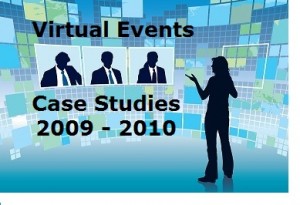 I recently completed a webinar with MPI on “Dispelling the 5 Myths of Going Virtual.” One of the questions asked was if I could provide a list of relevant case studies in this arena. I thought this would be a great resource to provide and I will add new case studies as I find them to this list.
I recently completed a webinar with MPI on “Dispelling the 5 Myths of Going Virtual.” One of the questions asked was if I could provide a list of relevant case studies in this arena. I thought this would be a great resource to provide and I will add new case studies as I find them to this list.
For now, I purposely looked at case studies from 2009-2010. These were based on articles, blog postings and case studies from vendors, including Imaste and Unisfair. Unfortunately, 6Connex and Inxpo required registration, On24 and Ubivent case studies were outdated, and VisualMente didn’t provide full details regarding objectives and results. If there are relevant case studies, please include them in the comments below.
Corporate Virtual Events Case Studies
- * HP goes virtual – Technology – Event Marketer: Overview of HP’s use of virtual event technology
- * Physical to Virtual Event Transformation – An Interview with SAP’s …: Interview with Scott Schenker of SAP regarding SAPPHIRE – looks at strategy and results.
- * Cisco Blog ” Blog Archive ” Virtual Event Key Learnings – Part Two: Key stats regarding CiscoLive 2009
- * Event Marketer: Cisco GSX Goes Virtual: Overview of Cisco GSX in Event Marketer Magazine
- * Cisco GSX 2009 Case Study on Vimeo: Cisco GSX case study.
- * Cisco Blog ” Blog Archive ” Analysis of a Virtual Event: Cisco Live case study – provides details of post-event survey between physical and virtual audiences
- * Avatars Rising in the Enterprise: GE Healthcare’s virtual exhibit highlighted.
- * KPMG Job Fair Attracts 10,000: Case study overview
- * Ariba Curbs Spending Virtually: Case study overview
- * CA’s Virtual Product Launch: Case study overview
- * Planview Grows Attendance at Virtual User Conference: Case study overview
- * ACS Drives Innovation with Virtual Training: Case study overview
- * Intuit Builds Community in the Virtual Classroom: Case study overview
- * Monster eDays: Case study overview
- * Virtual Job Fair in Brazil: Case study overview
- * Deloitte Spain Virtual Career Fair: Case study overview
Associations – Virtual Events Case Studies
- * Measuring and Maximizing the Impact of a Hybrid Event – The Virtual …: Case study on Virtual Edge Summit 2010 – look at physical and virtual attendees
- * American Payroll Association Trains Members Virtually: Case study overview
- * Grease, Gears, and Geo-location: IMTS Gets Its Social Media Groove On: IMTS case study on using social media
Publishing Virtual Events Case Studies
- * Hybrid Events: The Live/Virtual Combo – emedia and Technology …: UBM Studios discusses virtual for revenue
- * Virtual Events Come Into Their Own: Folio Magazine article that included information from Watt Publishing, Forbes, Nielsen, Futures nd Haymarket Media.
Higher Education/Government Virtual Events Case Studies
- * Virtual Environment Lab for Universidad Politécnica Madrid: Case study overview
- * On Campus Job Fair for Madrid regional government: Case study overview
- * Tour del Empleo Virtual: Case study overview of 25 Spanish Universities
PRMM Interview – Scott Kellner of 6Connex on Virtual Events

Every Friday, I try to interview an industry expert to provide insight on their industry. This week on PRMM Interview, I interview Scott Kellner, CMO of 6Connex, regarding what the future holds for virtual events and the best way to keep people engaged virtually.
As CMO of 6Connex, Scott is responsible for all communications activities and initiatives for 6Connex, including corporate, product, and channel marketing. He also supervises the 6Connex Service and Support group. Scott brings more than 20 years of marketing leadership to 6Connex. He has established branding and positioning strategies for a variety of companies, both as an agency executive and as senior, corporate marketer. Scott has also implemented the development and training of international reseller networks, managed direct sales organizations, and developed go-to-market, alliance marketing, advertising and PR strategies for companies in industries ranging from entertainment to professional services to consumer packaged goods.
Can you provide a quick intro to 6Connex?
One of the questions we often get is where our name comes from. I think it’s important to cover this because our name underscores our view of the virtual experience industry. The name comes from a combination of: the six degrees of separation connected at a nexus point. As such, our core mission is to connect people with each other, and with relevant content.
While we formally launched in February of 2009, our beginnings can be traced back to the first, and still the largest, virtual event every produced: AMD’s Virtual Experience (or AVE), which was run on 6Connex technology in 2006, and again in 2007. With just under 1 million unique registrants and statistics like 330,000 video views and more than 600,000 document downloads, it was truly a monumental undertaking. That experience, and the software that powered it, launched the company, though we stayed in stealth mode for two years.
Webinars have become a common lead generation tool for marketers. Can you provide 2-3 reasons why marketers should consider virtual events?
Given the way we’ve architected our platform, we believe marketers should consider virtual experiences for more than just events. That said, webinars are a tremendous tool, but they are usually effective for just a moment in time. While there are varying technologies, their efficacy is brief, and they don’t offer the level of flexibility, measurement, rich media content distribution or social networking that solid virtual platforms do.
We counsel our customers to use webinars as a key part of virtual experiences, but to also to take advantage of the ongoing presence afforded by virtual platforms to continually reach out to target audiences, refresh content, encourage interaction and create networks of professionals that can benefit from one another’s expertise.
Some of the best examples of this go beyond mere “events”. We encourage our customers to think in terms of both short and long term objectives, and to utilize the flexibility of virtual technology systems to continually engage their target constituencies. Cisco’s Data Center of the Future, and Siemens’ Navigating Healthcare virtual experiences are great examples of this. Simply put, webinars can do that.
As virtual events become more prevalent, there is a risk of attendee fatigue. What recommendations do you have to keep the experience fresh for attendees?
As many in your audience know, our heritage is not only in software development, but also award-winning interactive strategy and design. 6Connex has created virtual environments and critically acclaimed Web-based gaming programs for Disney, Universal Pictures and ABC, for example, so we understand, at a deep level, things like how to use video effectively, how to create a user experience that’s engaging and meets business objectives, and how to walk the fine line between attendee length of stay and the ease of finding relevant content.
To avoid fatigue, a virtual environment must be both pleasing and intuitive. It must have best in class information architecture, user interface design and be quick to load. But it must also be designed to allow attendees to chart their own path if they want. We believe you avoid weariness by making a virtual experience pleasing to the eye, by enabling people to connect with one another easily and by allowing attendees to encounter content on their own terms.
There seems to be a lot of developments with virtual events. Where do you see the industry going in 2-3 years?
Well, I have to be careful here. I don’t want to tip my hand in terms of what 6Connex has in alpha and beta stages now, though our customers are all in the loop. I will say this: I think better collaborative tools are on the immediate horizon. Improving the effectiveness of virtual platforms will require that providers enable secure, collaborative workspaces for their customers to use.
Another area of innovation centers on video conferencing, for sure. Creating more lifelike environments that complement physical events will continue to be necessary.
Also, integration with physical event technologies will become more important. One great example of this is “pushing” virtual content into a physical space via digital signage. We’re all familiar with “hybrid” events that take in live feeds from physical venue keynote addresses, for example. But we see no reason it cannot work the other way around.
Last, mobile is an obvious area for innovation. The increasing adoption of tablets and personal consoles like the iPad will drive some of this, but the most innovative virtual software providers will seek to push some envelopes in this arena on their own. Stay tuned!
Dispelling the 5 Myths of Going Virtual
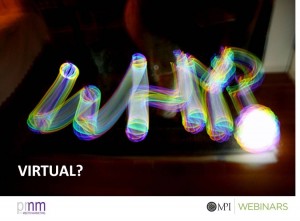 I recently presented a webinar on “Dispelling the 5 Myths of Going Virtual.” My presentation slides are included below and an archived version of the webinar will be available on the MPI website shortly. Free to MPI webinars, the on-demand will be available for $20. The webinar covered these top myths, accompanying case studies and relevant industry stats:
I recently presented a webinar on “Dispelling the 5 Myths of Going Virtual.” My presentation slides are included below and an archived version of the webinar will be available on the MPI website shortly. Free to MPI webinars, the on-demand will be available for $20. The webinar covered these top myths, accompanying case studies and relevant industry stats:
1. Virtual Will Cannibalize My Audience: Case study of American Payroll Association
2. Virtual Will Cannibalize My Exhibitors/Sponsors: Case study of GE Healthcare
3. Co$t$ Too Much: Case study of IMTS
4. Only for the Technically Savvy: Look at technology pace of technology adoption
5. Not as Good as F2F: Case study of CiscoLive Virtual
6. BONUS Myth: No One is Doing It
About
Favorite Service
Recent Comments
- on Going Virtual Isn’t Necessarily the Answer to Replacing Your Physical Events
- on Going Virtual Isn’t Necessarily the Answer to Replacing Your Physical Events
- on Going Virtual Isn’t Necessarily the Answer to Replacing Your Physical Events
- on Going Virtual Isn’t Necessarily the Answer to Replacing Your Physical Events
- on Going Virtual Isn’t Necessarily the Answer to Replacing Your Physical Events
Ads by Google
Favorite Books
Marketing Blogs
PR Blogs
- KD Paine's Measurement Blog
- Micro Persuasion
Virtual Events & Meetings Blogs
- Cisco Virtual Environments
- It's All Virtual
- The Webinar Blog
- Virtual Edge Institute

 Follow
Follow
 Cece Salomon-Lee is director of product marketing for Lanyon Solutions, Inc. and author of PR Meets Marketing, which explores the intersection of public relations, marketing, and social media.
Cece Salomon-Lee is director of product marketing for Lanyon Solutions, Inc. and author of PR Meets Marketing, which explores the intersection of public relations, marketing, and social media. 